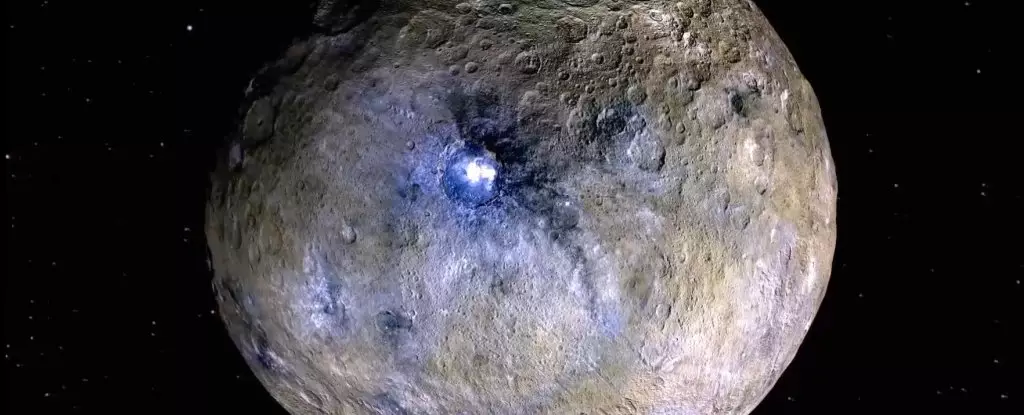Ceres, the largest object in the asteroid belt situated between Mars and Jupiter, has long intrigued scientists and astronomers alike. Originally classified as an asteroid when it was first spotted in 1801, this spherical celestial body is distinct enough to be considered a dwarf planet. Recent findings suggest that beneath its rough and heavily cratered exterior lies an astounding composition that could reshape our understanding of ice-rich celestial bodies. Researchers now posit that Ceres may contain a crust made up of over 90% water ice, which presents a new layer of complexity in the study of planetary science.
The notion that Ceres may harbor significant amounts of water ice alters our perception of what constitutes an “ocean world.” Historically, ocean worlds like Europa and Enceladus have been the focal points of studies due to their icy surfaces covering vast oceans of liquid water below. Ceres, however, is unique in its proximity to the Sun and the absence of tidal forces that would typically keep its interior warm and potentially liquid. This leads to an interesting question: how did this dwarf planet evolve to its current state?
NASA’s Dawn spacecraft, which arrived at Ceres in 2015, revolutionized the way we perceive this dwarf planet. Initial assessments suggested that the surface of Ceres was not historically stable, essentially citing that the cratering process would indicate a low percentage of water ice — no more than 30%. Conventional wisdom held that if Ceres had a substantial amount of ice, its surface would exhibit signs of flow and deformation over geological timescales, smoothing out the craters.
However, the findings from the Dawn mission presented well-defined craters that contradicted these earlier expectations. The unexpected preservation of these craters hinted at a possibly more complex relationship between Ceres’s ice and rocky materials than once thought. Planetary geophysicist Mike Sori from Purdue University delves into this aspect, indicating that ice, mixed with even minor amounts of solid rock, exhibits greater structural integrity than previously believed.
In a collaborative effort led by planetary scientist Ian Pamerleau, researchers used data from the Dawn mission alongside advanced computer simulations to explore the properties of Ceres’s crust. The simulations revealed that minor impurities mixed with water ice could significantly bolster its strength, enabling it to retain its morphological features over time. This reinterpretation of the strength of Ceres’s icy crust represents a paradigm shift in our understanding of its geological profile.
Through their simulations, the team found that a gradual transition from a water-ice-rich crust to a more rocky substrate below would allow for the maintenance of well-defined craters. This discovery is crucial as it establishes a potential mechanism for the preservation of these geological features, suggesting that Ceres could indeed possess a highly icy crust without the disruptive effects of geological activity commonly observed on other celestial bodies.
If Ceres is indeed predominantly made up of water ice, its implications extend beyond its own geological history; they invite comparisons with other ocean worlds in the Solar System, such as the icy moons of Jupiter and Saturn. These moons, which are believed to have thick icy shells under which vast oceans are maintained by gravitational interactions with their parent planets, offer a fascinating array of contexts for the potential frozen ocean of Ceres.
Conversely, Ceres’s lack of tidal heating means that any ocean it once had would likely have completely frozen over. Sori suggests that Ceres was once much like Europa—a world with a “dirty, muddy ocean” that gradually solidified into the ice-rich form we see today. This realization raises questions about the diversity of ocean worlds and suggests that they might be more varied in form than the canonical icy moons we currently study.
The Future of Exploration at Ceres
The unique qualities that Ceres displays make it an interesting focal point for future exploration. The potential classification as a frozen ocean world located relatively close to Earth offers researchers a valuable opportunity for comparative studies. Scientists envision that the insights gleaned from Ceres could pave the way to a deeper understanding of the icy moons of the outer Solar System.
Ceres emerges not only as an intriguing dwarf planet but as a compelling candidate in the ongoing quest to understand the cosmos. Its possible substantial water-ice crust invites a reexamination of ocean worlds and highlights our ever-evolving knowledge of planetary composition. The continued investigation of Ceres, whether through further spacecraft missions or advanced robotic exploration, is set to illuminate the mysteries not just of one dwarf planet, but the broader terrain of celestial bodies in our Solar System.



Leave a Reply